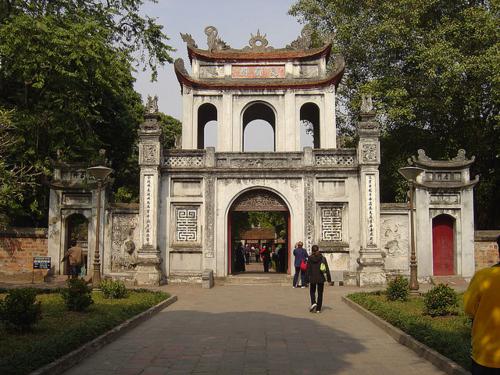Built in the latter part of the ninth century, Van Mieu is one of the oldest universities in the world. Its original purpose was the worship of the sages and saints of Confucianism, but six years later, a National College was established on the site. Initially, it admitted only princes, but soon expanded to admit bright students nationwide.
The Temple of Literature is surrounded by brick walls. Inside, the complex is separated into five areas. The first area contains the main gate with the inscription “Van Mieu Mon” (Disciple of Temple of Literature) and two stone dragons in the style of the Le So Dynasty.
The main path leads through another gate to the second area where there are two small gates on both sides. The main path leads to Khue Van Cac (Pavilion of Literature). There are also two small gates on both sides of Khue Van Cac.
The third section divides Khue Van from the Dai Thanh Mon (the Gate of Great Synthesis), and contains a square lake, Thien Quang Tinh (the Well of Heaven’s Clarity), surrounded by walls. On both sides of the well are pavilions full of stelae inscribed with the names of Ph.D scholars.
The Confucian education system
After years of study, students were allowed to take the first-degree examinations held once every three years. Those with the highest marks in this exam were named bachelors. A year later, they would travel to the capital to take part in a further set of examinations. Those with the highest marks became were awarded a doctorate. As a Ph.D., a scholar was then eligible to join the ranks of the mandarins.
There are 82 steles, the oldest relating to the 1442 palace exam and the most recent, the 1779 exams. They are the most valuable relics in the Temple of Literature.
The heart of Confucianism
Beyond the next gate is the fourth area. It contains a large courtyard flanked by two pavilions originally used to house the altars where scholars could worship the 72 disciples of Confucius. At the rear is Dai Bai, the Great House of Ceremonies, containing a bell cast in 1768 and other precious objects.
The University
The fifth section, at the rear of the Dai Bai area, is the Imperial College of the Le Dynasty, the then university. When the Nguyen Dynasty moved the college to Hue, this area was converted into a temple dedicated to Confucius’ parents.
The old University building was destroyed during the war, but was accurately reconstructed in 2000 using authentic materials and techniques to launch the countdown to Hanoi’s millennium in 2010.
Van Mieu then and now
In the past, Van Mieu was held in great reverence not only as a major centre of Confucian thought and study, but also for its status as the apogee of learning in Vietnam and the only route to becoming a mandarin. Regardless of rank, those on horseback were obliged to dismount and walk their steeds when passing the in front of the complex.
Today, the quiet queues of worshippers and acolytes have given way to tourist coaches that disgorge noisy tourists in their hundreds several times a day. Nevertheless, we recommend a visit, but arrange it to coincide with off-peak periods so that our visitors can experience the remarkable qualities of a place steeped the echoes of thousands of long dead scholars steeped in the pursuit of enlightenment.
Source: Haivenu-vietnam


